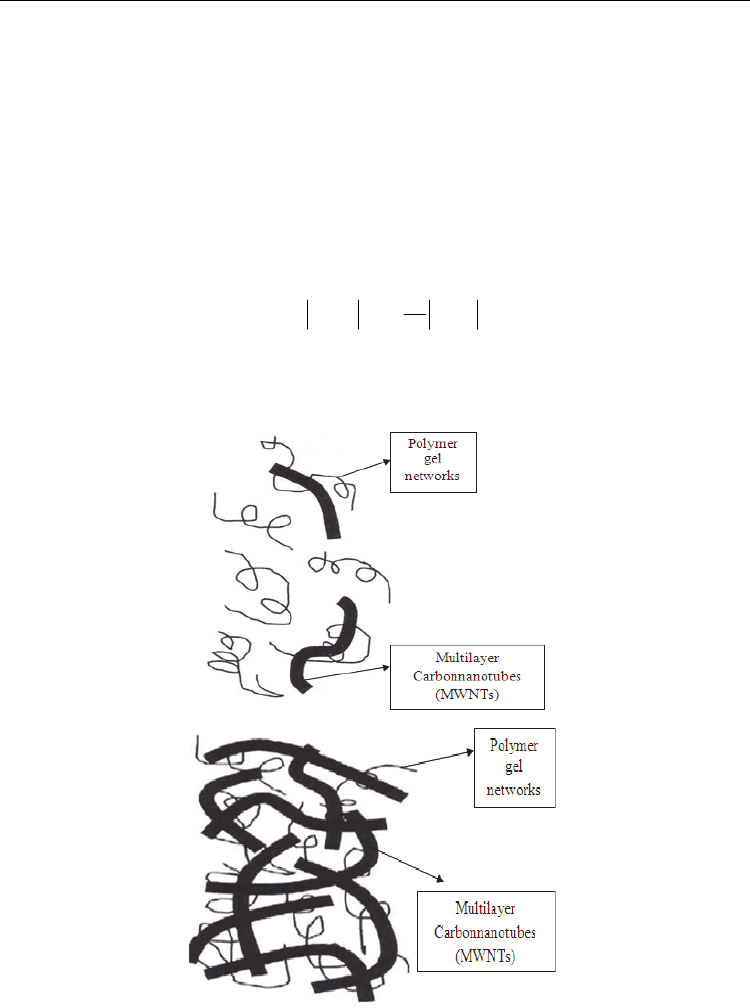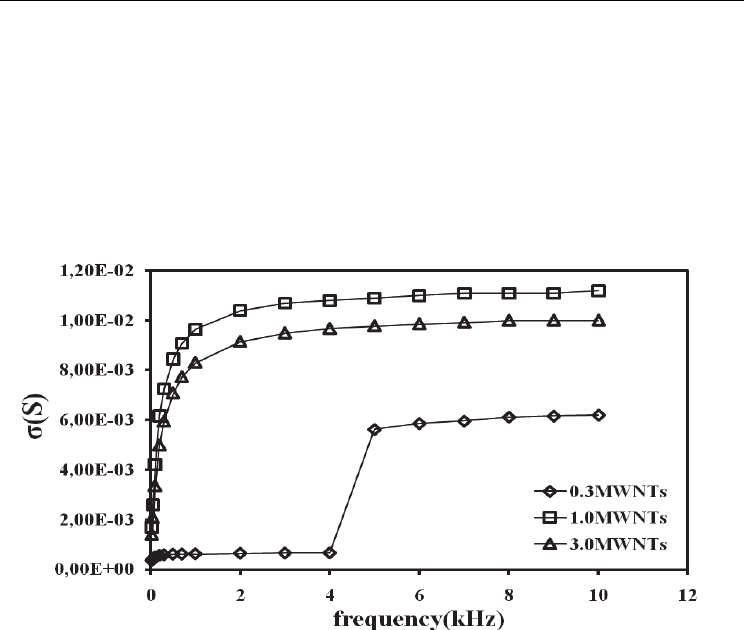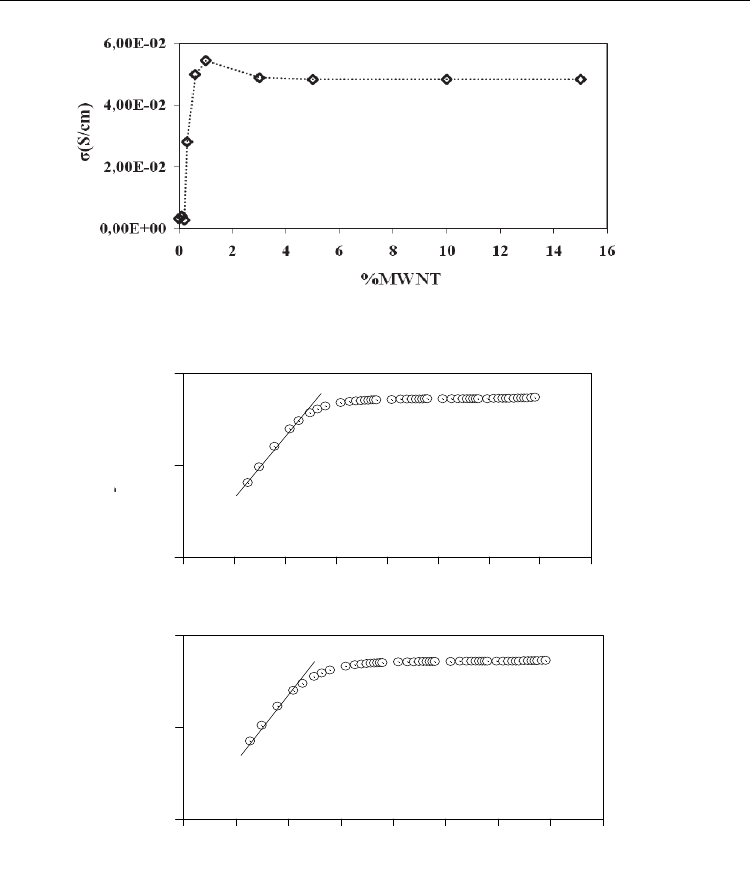Yellampalli S. (ed.) Carbon Nanotubes - Polymer Nanocomposites
Подождите немного. Документ загружается.

10
Conductivity Percolation of Carbon
Nanotubes in Polyacrylamide Gels
Önder Pekcan and Gülşen Akın Evingür
Kadir Has University,
İstanbul Technical University,
Turkey
1. Introduction
Polymer composites can be used in many different forms in various areas ranging from
structural units in the construction industry to the composites of the aerospace applications.
The extraordinary properties of carbon nanotubes make them very promising and favorable
as fillers for fabrication of a new class of polymeric heterostructures. Polymer matrices have
been widely exploited as a medium for carbonnanotubes (CNTs) which have been described
as effective conducting fillers for polymers. Nanotubes can be described as long and slender
fullerenes, in which the walls of the tubes are hexagonal carbon (graphite structure). There
are two main types of carbon nanotubes (CNT) known as single (SWCNT) and multiwalled
(MWCNT). Since the discovery of carbon nanotubes (CNT) in 1991 by lijima (lijima, 1991),
single- wall carbon nanotubes (SWNT) and multiwalled carbon nanotubes (MWNT) have
attracted great interests throughout the academic and industrial applications. Therefore,
many researchers are focused on the development of CNT-based polymer materials that
utilize the carbon nanotubes characteristics and properties, such as the high strength and
stiffness of the CNTs are used for developing superior polymer composites for structural
applications which are lighter, stronger, and tougher than any polymer-based material.
There are several important requirements for an effective improvement of CNT-based
composites’ properties, such as: a large aspect ratio of a filler, good exfoliation and
dispersion of nanotubes, and good nanotube-nanotube and nanotube-polymer interfacial
bonding. Numerous studies have shown already, that an effective performance of the
carbon nanotubes in composites for a variety of applications strongly depends on the ability
to disperse the CNTs homogenously throughout the matrix. Good interfacial bonding and
interactions between nanotubes and polymers are also necessary conditions for improving
mechanical properties of the composites. Because of their high mechanical strength, high
aspect ratio, small diameter, light weight, high electrical and thermal conductivities, and
high thermal and air stabilities, CNT have been found many applications in the industrial
world (Chang, 2006; Hu, 2006). Polymer composites with carbon nanotube addition are one
of the research subjects which attract huge attention in recent years (Lau, 2002& Thostenson,
2001). Thermoplastic polymers are usually used as an insulating material because of their
low electrical conductivity properties (10
-15
S/m). Dispersing the conducting filler such as
carbon black and CNT in polymer phase forms conductive polymer composites. Electrical

Carbon Nanotubes – Polymer Nanocomposites
198
resistivities of polymer-MWCNT composites which are strongly dependent on the volume
or mass fractions of the CNTs may vary between 10
16
to several ohms. At low volume or
mass fractions, the resistivity remains very close to the resistivity of pure polymer.
Insulating polymers are transformed to conductive composites by addition of CNTs above a
critical concentration threshold (known as percolation threshold). When the positions of
CNTs in the polymer matrix form a conducting network, the conductivity of composite
sharply increases. This phenomenon is known as percolation and can be well explained by
percolation theory (Stauffer, 1994). Percolation threshold can be determined by measuring
the resistivity variations in composites. Electrical percolation thresholds for some MWCNT
and SWCNT polymer-composites were reported as ranging from 0.0021 to 15 wt%
(Bauhofer, 2009). Studies on polymer-CNT composites show that their electrical, mechanical
and thermal properties are improved by addition of CNTs (Chang, 2006; Choi, 2007; Du,
2004; Gao, 2007; Park, 2007). The first polymer nanocomposites using carbon nanotubes as
filler were reported in 1994 by Ajayan (Ajayan, 1994). Earlier nanocomposites were used
nanoscale fillers such as carbon blacks, silicas, clays, and carbon nanofibers (CNF) to
improve the mechanical, electrical, and thermal properties of polymers. In recent years,
carbon nanotubes have been used to improve electrical and mechanical properties of
polymers (Anazawa, 2002; Choi, 2007; Du, 2004; Gao, 2007; Park, 2007; Moniruzzaman,
2006). However, by some reason of the advantage, provided by surface morphology, the
literature focused on polymer composite thin films (Andrews, 2002; Bin, 2006; Blanchet,
2003; Hill, 2002; Kymakis, 2002; Shaffer, 1999; Qian, 2000) while there are no detailed studies
on tri-dimensional composite gels with carbon nanotube content. Recently, carbon
nanotubes and their polymer composites are used in various industrial areas such as flat
panel screens, electron microscope guns, gas discharge tubes, microwave amplifiers, fuel
cells, batteries, hydrogen storing media, nano probes, sensors and body-parts of aircrafts
and spacecrafts (Ajayan, 2001). Some CNTs are stronger than steel and lighter than
aluminum and more conductive than copper (Ajayan, 2001). Thus, studies on polymer-CNT
composites have been accelerated at last decade.
Composite gels appear during a random linking process of monomers to larger and larger
molecules. Even though the sol-gel transition is not a phase transition in thermodynamic
sense, being a geometrical one, as a subject of critical phenomenon, it behaves like a second
order phase transition and constitutes a universal class by itself (Tanaka, 1981).
Experimental techniques used for monitoring sol-gel transition must be very sensitive to the
structural changes, and should not disturb the system mechanically. Fluorescence technique
is of particularly useful for elucidation of detailed structural aspects of the gels. This
technique is based on the interpretation of the change in anisotropy, emission and/or
excitation spectra, emission intensity, and viewing the lifetimes of injected aromatic
molecules to monitor the change in their microenvironment (Barrow, 1962; Birks, 1970;
Herculus, 1965; Galanin, 1995).
Electrical measurements are an unambiguous criterion of the existence of a percolated
network in the case of conductive fillers in an isolating matrix. Dielectric measurements
performed with varying frequency can lead to additional information about the percolation
network as it was shown for percolation structures of carbon black in polymeric matrices.
Recently, results on percolated structures of carbon nanotubes in disc sheet dry gels were
presented (Pötschke, 2004). Similarly, the AC and DC conductivities of carbon nanotubes-
polyepoxy composites have been investigated from 20 to 110
0
C in the frequency range 10
-2
-

Conductivity Percolation of Carbon Nanotubes in Polyacrylamide Gels
199
10
6
Hz as a function of the conductive weight fraction, p ranging from 0.04 to 2.5 wt%
(Barrau, 2003). The ability of existing theories to predict electrical properties of conductive
fiber composites have been examined (Weber, 1997). Complex permittivity and related AC
conductivity measurements in the frequency range between 10
-4
- 10
7
Hz are presented for
composites of polycarbonates (PC) filled with different amounts of multiwalled carbon
nanotubes (MWNTs) varying in the range between 0.5 and 5 wt% (Pötschke, 2003). In
addition, the conductivity of dry gel composites such as polystyrene (Chang, 2006) and
polypropylene (Seo, 2004) has been enhanced significantly with the addition of CNTs. On
the other hand, the PAM –CNTs composite thin films was characterized by the instruments
of Fourier transform infrared spectroscopy, UV absorbance spectra, fluorescence spectra and
transmission electron microscope (Li, 2004) Dielectric spectroscopy represents a method
which has been successfully applied to investigate the percolation structure of CNTs in
polymer (see, e.g.(Chang, 2006; Hu, 2006; Seo, 2004)). Therefore, we expect that this method
can lead to new insights in MWNTs doped systems.
This work initially aims to study the influence of MWNTs dispersion on gelation (occurring
composite gels) and conductivity properties of composites. In this work, when polymer
systems which are initially of isolator character doped with carbon nanotubes of nano
dimensions and when amount of such addition exceeds a critical value known as
percolation threshold, composite gel systems with carbon nanotube addition capable of
electrically converting into conductor structure are obtained. Composite gels are analyzed
using the steady state fluorescence and dielectric spectroscopy. Here the total monomer
concentration is kept 2M and very small amount of pyranine added to the pre-
polymerization solution presented a spectral shift to the shorter wavelengths upon the
initiation of polymerization. This spectral shift is due to the binding of pyranine to the
polymer chains during the formation of PAM-MWNTs composite gels. The pyranine, thus,
becomes an intrinsic fluoroprobe while it is extrinsic at the beginning of the reaction. The
fluorescence intensity of the pyranine bonded to the strands of the polymers allows one to
measure directly the gel fraction near the sol-gel phase transition, and thus the
corresponding critical exponent,
.
Finally this work is designed to investigate the percolation structure of conductivity, and the
state of dispersion of MWNTs in polyacrylamide using dielectric spectroscopy. Here critical
conductivity exponent, around the conductivity percolation threshold where a material
shifts to a conductor from an insulator character, is determined and found to be about 2.0 in
agreement with random resistor network.
2. Theoretical considerations
2.1 Conductivity percolation
It has been established the percolation theory has been used to interpret the behavior in a
mixture of conducting and non conducting components (Weber, 1997). Schematic
representation of electrical percolation threshold (before and after) is shown Figure 1. Direct
connection and overlapping of the CNT is not necessary i.e. nanotubes do not need to
physically touch each other for conductivity. Nanotubes can just be close enough to allow
for a hopping/ tunneling electron effect; these mechanisms require the CNT- CNT distance
to be less than 5nm. As a result, a higher volume fraction of CNTs filler is needed to achieve
electrical percolation threshold (Hu, 2006). Two classes of models have been developed for
the description of the frequency dependence of the complex conductivity

Carbon Nanotubes – Polymer Nanocomposites
200
*
() '() ''()wwiw
(1)
where σ` (w) real part, σ`` (w) imaginary part of the complex conductivity, i imaginary unit,
and w, angular frequency in percolating systems:
the equivalent circuit model which treats a percolation system as a random mixture of
resistors and capacitors(Bergman, 1977; Stauffer, 1994) and (ii) model based on charge
carrier diffusion on percolating clusters (Sahimi, 1994; Stauffer 1994) For two-
component systems- percolation cluster of high conductivity (σ
1
) embedded in a matrix
of considerable lower conductivity (σ
2
, σ
2
≪
σ
1
)
macroscopic effective conductivity near the percolation threshold p
c
can be written in
the scaling form (Bergman, 1977; Stauffer, 1994; Straley, 1977).
()
'' '
2
1
1
(, ) '
rrs
cc
pw p p p p
(2)
where p` is the concentration of conducting filler,
and
denote scaling functions for
''
c
pp
and
''
c
pp
respectively, s and r are the critical exponents.
Fig. 1. Schematic of MWNTs/gel composite, before and after the gel formation with
isotropic orientation of nanotubes.

Conductivity Percolation of Carbon Nanotubes in Polyacrylamide Gels
201
These models treat a percolation system as a random mixture of resistors, R and capacitors C
having a characteristic relaxation time
0
1
RC
w
, scaling law Eq. 2 for the complex
conductivity near the percolation threshold takes the form (Bergman, 1977; Pearson, 1978;
Seo, 2004)
()
*'' '
0
1
(, ) '
rrs
cc
iw
pw p p p p
Rw
(3)
One of the main physical content of this key scaling law is the existence of a time scale
()
'''
'
0
11
rs
cc
p
ppp
p
(4)
that diverges as the percolation threshold is approached from both sides.
For the frequency dependence of AC conductivity at the percolation threshold Bergman and
Imry (Bergman, 1977) derived the following law:
'
()
r
rs
ww
(5)
where σ’, the real part of Eq.1; w, angular frequency; r and s critical exponents for
conductivity. A wide variety of approaches have been applied to the determination of these
exponents as given in Table 1 for 3D with references (Adler, 1990; Bergman, 1977; Derrida,
1983; Fisch, 1978; Gingold, 1990; Herrman, 1984; Sahimi, 1994; Straley, 1977).
System
r s
References
Resistor lattice 1.70
0.05 0.70
0.05 Straley, 1977
Random resistor network 1.95
0.03 - Fish and Harris, 1978
Random resistor network 2.02
0.05 - Adler,1990
Random resistor lattices 2.003
0.047 - Gingold and Lobb, 1990
Random resistor network 1.9
0.1 0.75
0.04
Herrman, 1984
Derrida, 1983
Table 1. Critical exponents for electrical percolation threshold in three dimension (3D).
2.2 Sol-gel phase transition
In the past half century various models have been developed to describe gel formation,
among which Flory-Stockmayer theory and percolation theory provide bases for modeling
the sol-gel phase transition (Flory, 1941; de Gennes, 1988; Hermann, 1986; Stauffer, 1982,
1985; Stockmayer, 1943). Statistical theories based on tree-like structure (Bethe lattice) uses
mean field approximation, originate from Flory (Flory, 1941) and Stockmayer (Stockmayer,
1943), and assume equal reactivities of functional groups and the absence of cyclization
reactions. Most statistical theories derived in the following decades are fully equivalent,
differing only in mathematical language (Durand, 1979; Gordon, 1962; Macosko, 1976;
Pearson, 1978).

Carbon Nanotubes – Polymer Nanocomposites
202
Percolation offers a particularly simple and yet detailed picture in terms of which one may
seek to understand gelation (de Gennes, 1988; Stauffer, 1985, 1994). In the language of
percolation, one may think of monomers as occupying the vertices of a periodic lattice, and the
chemical bonds as corresponding to the edges joining these vertices at any given moment,
with some probability, p. Then, the gel point can be identified with the percolation threshold
p
c
, where, in the thermodynamic limit, the incipient infinite cluster starts to form.
Identifying the weight average degree of polymerization DP
w
with the average cluster size S
av
and the gel fraction G with the probability P
of an occupied site to belong to the incipient
infinite cluster, one can predict the scaling behavior of these and related quantities near the
gel point, as a function of
c
pp
,
w
c
DP
pp
p
p
c
-
(6)
c
Gpp
p
p
c
+
(7)
If p approaches
p
c
from below it is denoted as
c
pp
, in contrast,
c
pp
denotes when p
approaches
p
c
from above. Here,
and are the critical exponents, respectively. The critical
exponents in percolation theory,
=0.41 and
=1.70, differ from those found in Flory-Stockmayer,
=1
and
=1.
3. Experimental
PAM- MWNT composites were prepared from various amounts of AAm and MWNTs. The
solution is composed of MWNTs (Cheap Tubes Inc.), Polyvinyl pyrolidone (PVP), and
water. The AAm and MWNTs concentrations are given in (Table 2). BIS (Merck) dissolving
in 40x10
-6
m
3
of water in which 10
-4
lt of TEMED (tetramethylethylenediamine) was added as
an accelerator. The initiator, Ammonium persulfate (APS, Merck) was used and the initiator
and pyranine concentrations were kept constant at 7x10
-3
M
and
4x10
-4
M, respectively, for
all samples. All samples were deoxygenated by bubbling nitrogen for 10 minutes, just before
gelation process has started.
The Model LS-50 spectrometer of Perkin-Elmer was used for the fluorescence intensity
measurements. All measurements were made at 90
o
position and slit widths were kept at 5
nm. Pyranine was excited at 340 nm during
in situ gelation experiments and variation in the
fluorescence spectra and emission intensity of the pyranine were monitored as a function of
gelation time.
The AC conductivity measurements were carried out by means of an HP- 4192 A impedance
analyzer controlling a computer at room temperature. The dielectric cell was a parallel
capacitor with sample thickness of 2mm.
4. Results and discussion
4.1 Conductivity exponents
The conductivity as a function of alternative current frequency is shown in Figure 2 for the
gels with different content of PAM and/or MWNTs. It is observed that conductivity

Conductivity Percolation of Carbon Nanotubes in Polyacrylamide Gels
203
behavior of the composite gels increased exponentially by increasing AC frequency. The
results show that the critical conductivity behavior of the composite system occurs at 4 kHz
for lower MWNTs content while this behavior occurs nearly 0 kHz for higher MWNTs
contents. PAM doped by lower MWNTs composite system converts into conductive
character at higher frequency than the frequency value needed for PAM doped by higher
MWNTs composite system.
From figure 2, one can seen that the conductivity, (σ) of 0.3 %
MWNT gel was stable up to 4 kHz then suddenly increased to some point, and become
stable. On the other hand, the conductivity,
(σ) for 1.0 and 3.0 % MWNT gels increased
suddenly at very low frequency, then become stable after 4 kHz.
Fig. 2. Conductivity of PAM- MWNTs composites versus alternatively current (AC)
frequency at room temperature for 0.3 %MWNTs, 1.0 %MWNTs and 3.0 %MWNTs
contents, respectively.
The effect of MWNTs content on conductivity of PAM- MWNTs composite gels is
presented in Figure 3 for 5kHz. At very low content of MWNTs (0.3%), the conductivity
is quite low, however, after 0.3 %, a definite increase in conductivity is observed. This
stepwise change in conductivity is a result of the formation of an interconnected structure
of MWNTs and can be regarded as an electrical percolation threshold which simply
means that at contents between 0.3 and 1.0 % MWNTs, some percentage of electrons are
permitted to flow through the specimen due to the creation of an interconnecting
conductive pathway. At contents above 1.0 %MWNTs, the conductivities are stable by
increasing MWNTs content (Seo, 2004).
The value of the fitting exponent
r in Eq. 7 was estimated from the slope of the linear
relation between log σ and log
w as shown in Figure 4. s is the critical exponent which taken
from literature by s≈0.7±0.05(Straley, 1977). The produce r values are listed in Table 2 where
it is seen that the electrical percolation occurs above 0.3 % MWNTs with a critical exponent
around
r≈2 which is close to the theoretical prediction of this value in 3D percolated system
as known random resistor network (Derrida, 1983; Straley, 1977).

Carbon Nanotubes – Polymer Nanocomposites
204
Fig. 3. Conductivity as a function MWNTs content at 5 kHz.
logw
123456789
-3
-2
-1
0.6 %MWNTs
logw
123456789
lo
g
-3
-2
-1
3 % MWNTs
Fig. 4. Logarithmic plot of the conductivity versus frequency curves of 0.6 %MWNTs and 3
% MWNTs, respectively.
4.2 Sol-gel exponents
Figure 5 shows the typical fluorescence spectra of pyranine at two different stages of
gelation for PAM-MWNTs composite. Beginning of the reaction only the 512nm peak exists,
and then the intensity of the new peak around 380 nm started to increase as the intensity of
the 512nm peak decreased during the course of gelation of PAM-MWNTs composite gels.

Conductivity Percolation of Carbon Nanotubes in Polyacrylamide Gels
205
Fig. 5. Typical fluorescence spectra of pyranine at different stages of gelation
for PAM-
MWNTs composite during the whole course of gelation presenting the binding of pyranines
and at the early stage of gelation, presenting the spectral shift from 380nm toward 427nm,
respectively.

Carbon Nanotubes – Polymer Nanocomposites
206
AAm (%) MWNTs(%) t
g
el
(s) C
-
/C
+
r
100 0 300±5
1.0 0.92
-
0.37 0.50
0.28 0.55
0.23 0.52
0.1 0.52
99.9 0.1 300±5
1.0 0.75
0.10±0.02
0.37 0.50
0.28 0.56
0.23 0.48
0.1 0.50
99.8 0.2 300±5
1.0 1.05
0.57±0.02
0.37 0.50
0.28 0.65
0.23 0.60
0.1 0.50
99.7 0.3 300±5
1.0 0.75
0.34±0.02
0.37 0.66
0.28 0.58
0.23 0.55
0.1 0.50
99.4 0.6 360±5
1.0 0.96
1.80±0.02
0.37 0.67
0.28 0.60
0.23 0.55
0.1 0.55
99 1 420±5
1.0 0.90
1.90±0.02
0.37 0.65
0.28 0.57
0.23 0.65
0.1 0.60
97 3 420±5
1.0 0.83
1.90±0.02
0.37 0.51
0.28 0.48
0.23 0.50
0.1 0.50
95 5 480±5
1.0 1.10
2.30±0.08
0.37 0.70
0.28 0.63
0.23 0.68
0.1 0.65
